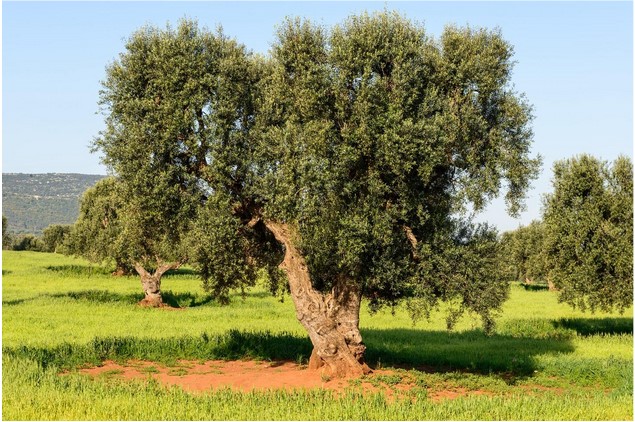Apulia’s olive trees are drying out due to a dangerous pathogen, but also because of decades of poor practices by landowners and the general effects of climate change.
The bacterium Xylella fastidiosa was probably introduced in Gallipoli (in the province of Lecce) following the importation of a coffee plant from Costa Rica. The pathogen adapted itself to the olive trees across the territory of Apulia, causing the death of nearly seven million olive trees since 2013, the year the bacterium was isolated. This event had been predicted, as it had already been discussed in a 2010 congress at the Mediterranean Agronomic Institute of Bari (IAMB), by the American scientist Rodrigo Almeida, who presented a paper titled ‘Xylella: Danger at the Gates’. This, and many other mysteries, marked the spread of the epidemic in the Salento peninsula, which led to strong public protests, investigations by the judiciary in Lecce, heated debates among scientists, and clear inadequacies in both national and regional politics. For a “historical” context of the spread of the olive tree disease known as the Quick Decline Syndrome of Olive (CoDiRO), we refer to the investigative book ‘Xylella Report’ by Marilù Mastrogiovanni, which has never been contradicted or legally challenged by any of the figures mentioned in the book.
What Future Awaits Apulia’s Olive Trees?
More than a decade after those events, the situation of the olive forest in the Salento peninsula (in southern Apulia) is as critical as ever. And while certain oversimplifications have seen the ‘killer bacterium’ as the sole cause of the olive tree CoDiRo, more updated comprehensive hypotheses are emerging, which consider the effects of climate change and the near sterility of overworked soils.
While protests by Apulian farmers intensify due to the lack of public policies aimed at tackling drought and pathogens, we sought further understanding by reaching out to the CMCC (Euro-Mediterranean Centre on Climate Change), a reputable independent research institute that develops studies and models on the climate system and its interactions with society, promoting adaptation and mitigation policies based on solid scientific knowledge. The CMCC Foundation put us in touch with Dr Gabriele Pizzileo, who works for the IAFES (Impacts on Agriculture, Forests, and Ecosystem Services) division. We interviewed him in July 2024, just over a decade after the appearance of the Xylella fastidiosa bacterium in the Salento peninsula. We asked him what can be done to counteract the ongoing deforestation taking place in the heel of Italy.

We asked Dr Pizzileo if there was any hope of saving the millions of olive trees scattered around Puglia, particularly in Salento.
I can surely give you an insight into good agricultural practices that can help mitigate the effects of climate change, especially in terms of emissions from agricultural operations. In fact, agriculture is one of the leading sectors in terms of greenhouse gas emissions, contributing precisely to climate change, the cause of these major catastrophes such as floods and droughts. Among the many useful practices to cope with alternating droughts and heavy rainfall, which are concentrated in specific periods of the year, is the use of cover crops. In the case of heavy rain, a grass-covered surface compared to a completely bare soil can mitigate the impact of water on the soil and channel it better, thanks to the roots of these herbaceous plants. Cover crops should be maintained until the start of the dry season, after which they should be sustainably managed through mowing. Nonetheless, this practice is frowned upon by some entrepreneurs, who are used to periodically working the soil to avoid the formation of a hard crust. This is particularly true in Salento, where the practice of allowing spontaneous or seeded grass to grow is not commonly used, as the tendency is to work the soil continuously.
How should the soil be worked?
Through tilling, with mechanical devices that actively work the soil, or employing harrows that only dig into the surface. We must bear in mind, however, that every time we work the soil, we are also mobilising all the microflora and microfauna that mineralise the organic substance within it. In soils already poor in organic substances, like ours, frequent tilling leads to a loss of fertility in terms of carbon and nitrogen stored inside. There is another negative backlash: nitrogen, besides being a plant nutrient, is a gas that has a significant climate impact. Agriculture releases great quantities into the atmosphere, both through fertilisation and mineralisation. Mowing also has very positive impacts on drought, because it creates a layer called ‘mulching’. This is a sort of coat a few centimeters thick that we placed on the soil; it prevents water from evaporating at the standard rate when the soil is bare. This helps to better store water, making it more available to plants, and to decrease the soil temperature given that its ability to reflect sunlight increases. This can also be achieved by managing pruning sustainably, composting the material, and then reapplying it to the soil; thus, avoiding phytosanitary problems or an increase in pathogen inoculation.
What is your opinion on the overuse of pesticides and herbicides?
Alongside the good agricultural practices I have described, farmers should rationally use phytosanitary protection, so that herbicides are not spread, for example, across the entire field but only under the plants. They should also consider using less impactful organic alternatives, perhaps in a preventive rather than curative manner. Informing farmers about these practices could benefit them in economic terms, as it will help them be more resilient and suffer fewer impacts from climate change. It would also certainly improve the land, enhancing the quality of life.
For farmers who have lost their olive trees to the Xylella fastidiosa drying disease, what kind of crops can they consider replanting in the territory?
This is one of our research topics. An online tool of ours will be released in the upcoming months to help farmers in this decision. We are assessing the climatic suitability of different crops that can assist farmers and cultivators in deciding what to plant and offering guidance on whether a crop will be suitable for the climate from now until 2050. The tool will likely cover the whole of Apulia, specifically the provinces of Lecce, Brindisi, and Taranto, which were most affected by Xylella.
Complementary Activity
Video
The Impact of Climate Change in Salento: Between Xylella and the Risk of Deserti



